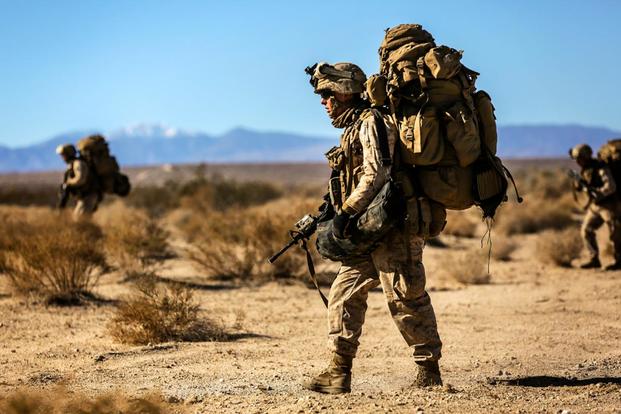The Marine Corps is gearing up for a complex ground fight by adding hundreds more infantry squad leaders, special operators, cyber Marines and information warfare experts, according to 2020 budget documents.
The Corps wants $45.9 billion in 2020, a 6 percent jump from last year's $43.1 billion budget request. The service's plans support a Pentagon-wide push to "prioritize close-combat lethality and build a future force oriented on meeting potential peer or near-peer adversaries," the budget documents state.
The Marine Corps is in the process of adding 330 new infantry squad leader billets. That number won't add to the overall size of the service. Instead, it is using "internal structure realignments" to create those slots, which will place "more experienced and better-trained leaders within the infantry formations," according to the budget documents.
The Corps is already throwing big re-enlistment bonuses at infantry noncommissioned officers to get experienced grunts to stay. About 110 of the new slots have already been filled, Maj. Craig Thomas, a spokesman for Marine Corps Manpower and Reserve Affairs, told Military.com.
"The remaining 220 [will] be filled through [fiscal 2020]," he said.
Related content:
- Navy Wants 5K More Sailors and Billions for New Ships, Will Retire a Carrier Early
- Air Force Asks for 4,400 More Airmen, New F-15EX Fighter in Budget Request
- Army Slashes Old Programs to Fund New Tech in 2020 Budget Request
- War Funding 'Gimmick' in Defense Budget Request Sets Up Congressional Battle
- It's Official: 2020 Budget Proposal Has Largest Troop Pay Raise in a Decade
The service's total end strength will increase by 100, up to 186,200 in fiscal 2020. Leaders want to fill those new positions with "Marines with special skills," the budget documents state, including those in special operations; intelligence operations; and electronic, information and cyber warfare.
"Our manning requires leaders with the grade, experience, technical and tactical qualifications associated with their billets, which is essential to the Marine Corps as a 'fight tonight' force," the documents state.
The service is also investing significantly in ground equipment, based on recommendations from the Close Combat Lethality Task Force, a group working to improve the survivability and performance of Army and Marine Corps infantry units.
The Marine Corps wants new 635 Carl Gustaf recoilless rifles, which Military.com reported in 2017 would be coming to every infantry squad. The 84mm weapon is replacing the MK153 Shoulder-Launched Multipurpose Assault Weapon, or SMAW.
The Corps is also funding 18,142 squad common optics, which can be used with the M4 carbine, M4A1 and M27 infantry automatic rifle. And Marines will get 1,463 squad thermal sights, which allow them to see in the dark, fog or other obscureness.
Bigger-ticket ground items include 56 amphibious combat vehicles totaling $332 million. And the Marine Corps will continue to put big money into High Mobility Artillery Rocket Systems. The service wants to spend $100 million on new HIMARS in 2020.
Long-range rocket and artillery capabilities are a big priority for the service, as Marines face new threats in the maritime environment. Commandant Gen. Robert Neller warned in a 2016 operating document that the challenge will continue to grow as adversaries try to hold Marines at bay at greater distances, denying their ability to maneuver.
Marines also want to be able to shoot down drones as the threat of unmanned aircraft has grown on the battlefield with the proliferation of cheap, off-the-shelf products. The Marine Corps hopes to spend $176 million on Ground-Based Air Defense systems next year.
There are also plans to purchase 10 more F-35B Joint Strike Fighters, which can take off from and land vertically on ships, and 10 F-35Cs. The Marine Corps also plans to buy six more CH-53K heavy-lift helicopters, down from eight budgeted last year.
Over the next five years, the service wants 110 F-35s and CH-53K King Stallions. The Marine Corps also wants three more MQ-9A Reaper drones.
And like the Navy, the Corps will purchase aircraft to prep its pilots for air-to-air combat. In total, the sea services plan to buy 22 F-5 Tiger IIs next year -- 11 for the Navy and 11 for the Marine Corps.
Editor's Note: This story has been updated with more accurate budget figures from the Navy.
-- Gina Harkins can be reached at gina.harkins@military.com. Follow her on Twitter @ginaaharkins.













